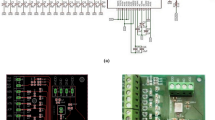Abstract
Lumped-parameter musculoskeletal model based on surface electromyography (EMG) promises to estimate multiple degrees-of-freedom (DoFs) wrist kinematics and might be potentially applied in the real-time control of powered upper limb prostheses. In this study, we proposed a new parameter calibration method based on the lumped-parameter musculoskeletal model. Compared with the existing calibration method in the lumped-parameter musculoskeletal model, this paradigm used an improved method of calculating estimated joint angles in optimization and a reduced training dataset (data from only single-DoF movements) to optimize model parameters. Surface EMG signals were then mapped into the kinematics of the wrist joint using the optimized musculoskeletal model. In the experiments, wrist joint angles and surface EMG signals were simultaneously acquired from able-bodied subjects while performing 3 movements, including flexion/extension (Flex/Ext) only, pronation/supination (Pro/Sup) only, and 2-DoF movements. The offline tracking performance of the proposed method was comparable to that of the existing calibration method with averaged r = 0.883 and NRMSE = 0.218. Moreover, the results demonstrated significant superiority of the proposed method over the existing method with less amount of data for parameter tuning, providing a promising direction for predicting multi-DoF limb motions with only single-DoF information.
Access this chapter
Tax calculation will be finalised at checkout
Purchases are for personal use only
Similar content being viewed by others
References
Farina, D., et al.: The extraction of neural information from the surface EMG for the control of upper-limb prostheses: emerging avenues and challenges. IEEE Trans. Neural Syst. Rehabil. Eng. 22(4), 797–809 (2014)
Graupe, D., Cline, W.K.: Functional separation of EMG signals via ARMA identification methods for prosthesis control purposes. IEEE Trans. Syst. Man Cybern. 5(2), 252–259 (1975)
Doerschuk, P.C., Gustafon, D.E., Willsky, A.S.: Upper extremity limb function discrimination using EMG signal analysis. IEEE Trans. Biomed. Eng. 30(1), 18–29 (2007)
Fougner, A., Stavdahl, O., Kyberd, P.J., Losier, Y.G., Parker, P.A.: Control of upper limb prostheses: terminology and proportional myoelectric control-a review. IEEE Trans. Neural Syst. Rehabil. Eng. 20(5), 663–677 (2012)
Davidson, J.: A survey of the satisfaction of upper limb amputees with their prostheses, their lifestyles, and their abilities. J. Hand Ther. 15(1), 62–70 (2002)
Englehart, K., Hudgins, B.: A robust, real-time control scheme for multifunction myoelectric control. IEEE Trans. Biomed. Eng. 50(7), 848–854 (2003)
Huang, H., Zhou, P., Li, G., Kuiken, T.A.: Spatial filtering improves EMG classification accuracy following targeted muscle reinnervation. Ann. Biomed. Eng. 37(9), 1849–1857 (2009)
Jiang, N., Englehart, K.B., Parker, P.A.: Extracting simultaneous and proportional neural control information for multiple-DOF prostheses from the surface electromyographic signal. IEEE Trans. Biomed. Eng. 56(4), 1070–1080 (2009)
Jiang, N., Dosen, S., Muller, K.R., Farina, D.: Myoelectric control of artificial limbs-is there a need to change focus? [In the spotlight]. IEEE Signal Process. Mag. 29(5), 150–152 (2012)
Crouch, D.L., Huang, H.: Musculoskeletal model predicts multi-joint wrist and hand movement from limited EMG control signals. In: Engineering in Medicine and Biology Society, pp. 1132–1135 (2015)
Sartori, M., Durandau, G., Dosen, S., Farina, D.: Robust simultaneous myoelectric control of multiple degrees of freedom in wrist-hand prostheses by real-time neuromusculoskeletal modeling. J. Neural Eng. 15(6), 066,026.1-066,026.15 (2018)
Lloyd, D.G., Besier, T.F.: An EMG-driven musculoskeletal model to estimate muscle forces and knee joint moments in vivo. J. Biomech. 36(6), 765–776 (2003)
Buchanan, T.S., Lloyd, D.G., Manal, K., Besier, T.F.: Neuromusculoskeletal modeling: estimation of muscle forces and joint moments and movements from measurements of neural command. J. Appl. Biomech. 20(4), 367–395 (2004)
Sartori, M., Reggiani, M., Farina, D., Lloyd, D.G.: EMG-driven forward-dynamic estimation of muscle force and joint moment about multiple degrees of freedom in the human lower extremity. PloS One 7(12), 1–11 (2012)
Crouch, D.L., Huang, H.: Lumped-parameter electromyogram-driven musculoskeletal hand model: A potential platform for real-time prosthesis control. J. Biomech. 49(16), 3901–3907 (2016)
Manal, K., Gonzalez, R.V., Lloyd, D.G., Buchanan, T.S.: A real-time EMG-driven virtual arm. Comput. Biol. Med. 32(1), 25–36 (2002)
Chadwick, E., Blana, D., van den Bogert, A., Kirsch, R.: A real-time, 3-D musculoskeletal model for dynamic simulation of arm movements. IEEE Trans. Biomed. Eng. 56(4), 941–948 (2009)
Pan, L., Crouch, D.L., Huang, H.: Musculoskeletal model for simultaneous and proportional control of 3-DOF hand and wrist movements from EMG signals. In: 8th International IEEE/EMBS Conference on Neural Engineering, NER, pp. 325–328. IEEE (2017)
Pan, L., Crouch, D.L., Huang, H.: Comparing EMG-based human-machine interfaces for estimating continuous, coordinated movements. IEEE Trans. Neural Syst. Rehabil. Eng. 27(10), 2145–2154 (2019)
Heine, R., Manal, K., Buchanan, T.S.: Using hill-type muscle models and EMG data in a forward dynamic analysis of joint moment evaluation of critical parameters. J. Mech. Med. Bio. 3(2), 169–186 (2003)
Corcos, D.M., Gottlieb, G.L., Latash, M.L., Almeida, G.L., Agarwal, G.C.: Electromechanical delay: an experimental artifact. J. Electromyogr. Kinesiol. 2(2), 59–68 (1992)
Author information
Authors and Affiliations
Corresponding author
Editor information
Editors and Affiliations
Rights and permissions
Copyright information
© 2020 Springer Nature Switzerland AG
About this paper
Cite this paper
Zhao, J., Yu, Y., Sheng, X., Zhu, X. (2020). An Improved Calibration Method of EMG-driven Musculoskeletal Model for Estimating Wrist Joint Angles. In: Chan, C.S., et al. Intelligent Robotics and Applications. ICIRA 2020. Lecture Notes in Computer Science(), vol 12595. Springer, Cham. https://doi.org/10.1007/978-3-030-66645-3_4
Download citation
DOI: https://doi.org/10.1007/978-3-030-66645-3_4
Published:
Publisher Name: Springer, Cham
Print ISBN: 978-3-030-66644-6
Online ISBN: 978-3-030-66645-3
eBook Packages: Computer ScienceComputer Science (R0)




